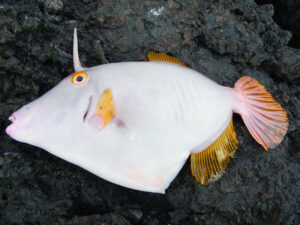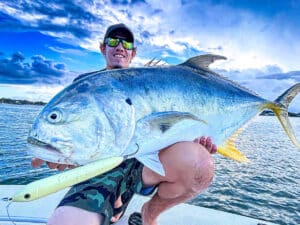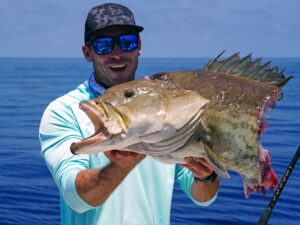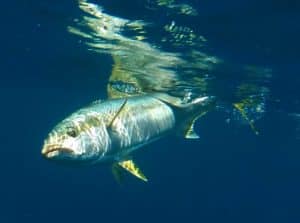In each issue of Sport Fishing magazine, a panel of five international expert ichthyologists identifies unusual and often amazing fishes in photos submitted by readers. Find out what they are and learn fascinating facts about them.
Mini Mack
QUESTION:
I’m hoping you can help me identify this fish caught on my boat near Fort Pierce, Florida, in the month of September. While I cast-netted white bait for the day’s charter, this little guy (3¼ inches long) slipped through the mesh of the net onto the deck. It didn’t look like the small herring or pilchards I was after, and upon a closer look, I could barely make out the posterior soft dorsal fins, the forked tail and what looked like teeth. We took a quick photo before releasing it back into the water. My first guess is a king mackerel, but I’m not sure. Can your Fish Facts experts identify this fish and offer any insight into how this guy came to be in the Indian River Lagoon?
Capt. Tim Simos
Fort Pierce, Florida
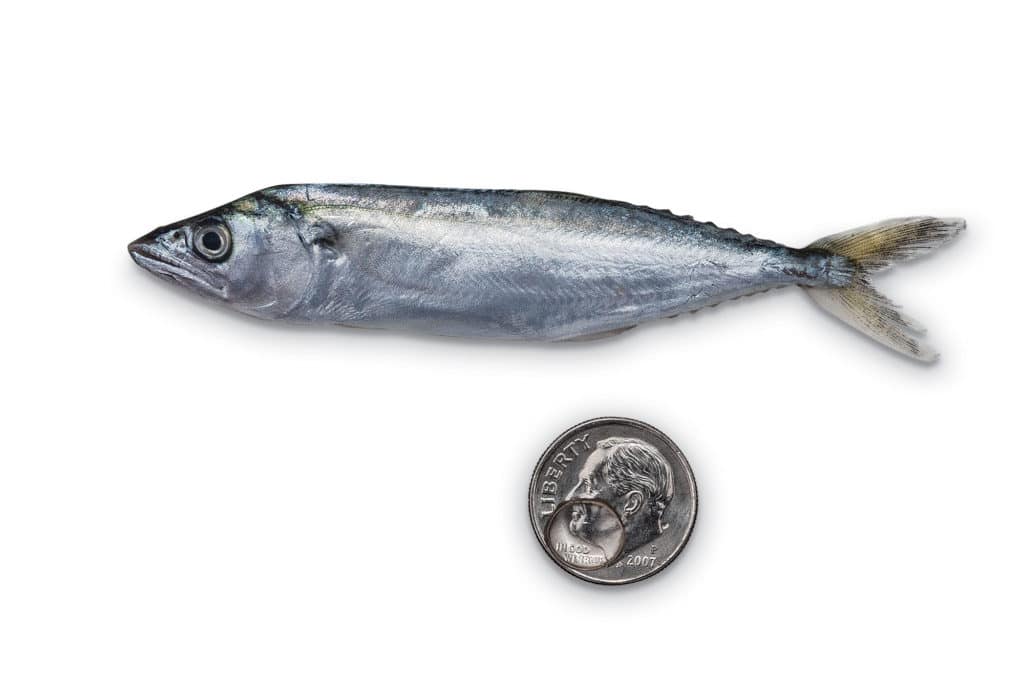
ANSWER:
You netted a juvenile mackerel, Tim. Most likely it’s a Spanish mackerel, Scomberomorus maculatus, but it could also be a cero mackerel, S. regalis. These two species are easily distinguished as adults by differences in the pattern of yellow spots/stripes on their sides, but juveniles have paler, often indistinct markings. A trait shared by these species — and which is obvious on the fish you netted — is a gradually sloping lateral line, as opposed to the abruptly sloping lateral line of king mackerel, S. cavalla. Both Spanish and cero mackerel range as far north as Massachusetts, but the cero is common throughout the Bahamas and Caribbean, while the Spanish mackerel, reported from Cuba and Haiti, is apparently absent from the Bahamas. Additionally, the cero ranges south to Brazil, while the Spanish mackerel is replaced by the Serra Spanish mackerel, S. brasiliensis, south of the Yucatan Peninsula.
Both Spanish and cero mackerel spawn in Florida waters; Spanish mackerel appear to spawn there from summer through early fall, and cero may spawn year-round. The eggs of both species are buoyant and may be carried into estuaries or inland areas; juvenile Spanish and cero mackerel often use estuaries as nurseries. Your fish could have reached the Indian River Lagoon either before or after hatching.
Both Spanish and cero mackerel are somewhat oily and spoil rapidly if not cared for properly following capture. Their taste is stronger than some folks like, but they can be delicious when bled promptly after being caught, then broiled. Anglers also frequently smoke these mackerels, using them as the basis of fish dip. Both species have occasionally been associated with ciguatera poisoning. The Florida record for Spanish mackerel is 12 pounds; for cero, it’s 17 pounds, 2 ounces.
—Ray Waldner
Caribbean Anomaly
QUESTION:
We caught this fish and another like it while slow-jigging in 400-plus feet of water off Tobago. No one seems to know what it is. Can you identify it for me?
Robert Django Stauble
Houston
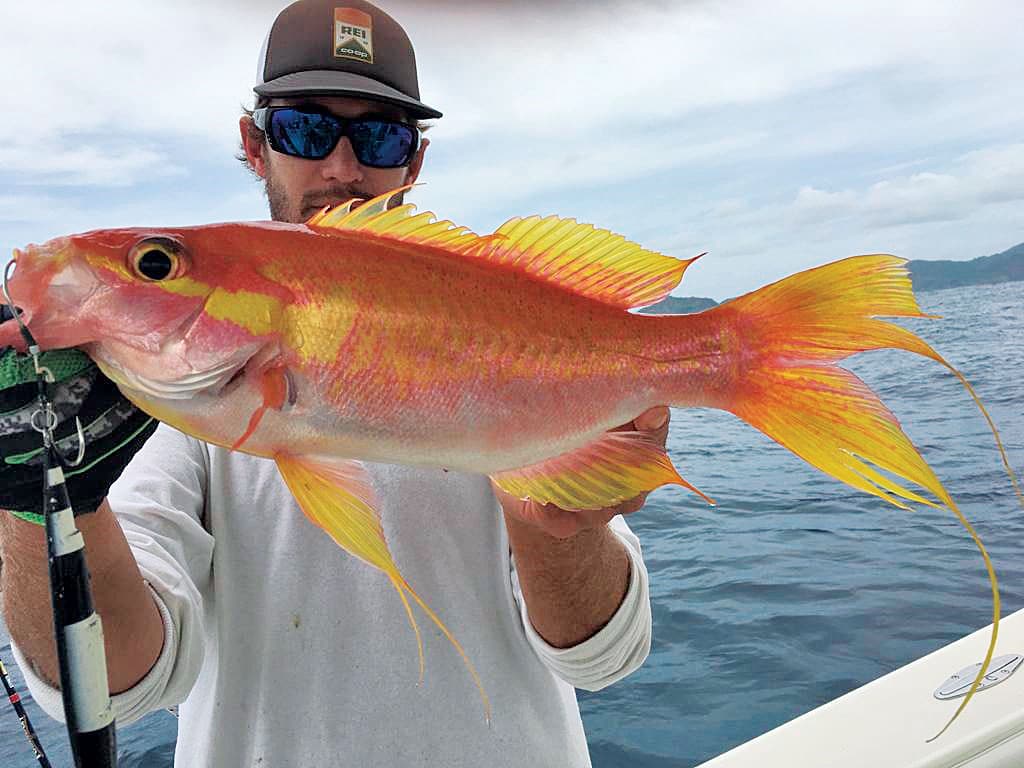
ANSWER:
Wow — that’s an interesting catch, Django. It’s obviously a member of the Anthias complex, which consists of a number of small, brightly colored sea basses belonging to several closely related genera. But what’s most interesting is that it doesn’t match up with any of the species known from the western central Atlantic/Caribbean Sea area. Its pigmentation closely matches the longtail bass, Hemanthias leptus, but that species lacks the extended caudal rays (streamers off the tail), evident in the photograph of your fish. Some western central Atlantic anthiids have extended caudal rays, including the red barbier, Baldwinella vivanus, and the streamer bass, H. aureorubens, but the fish you caught differs in pigmentation from these other species, and the streamers on your catch’s caudal fin originate from the center of the fin rather than from the outer rays. There is an Eastern Pacific species — H. peruanus, the splittail bass — that has a caudal fin and pigmentation like that of your catch. Unfortunately, without a specimen in hand, I can’t tell if your fish in fact could be a splittail bass. If so, that would represent a considerable range extension for the species. Or perhaps it could be a yet-undescribed species. Hopefully you or another angler will catch another specimen in those waters and preserve it for scientific study!
—Ray Waldner
Rare King-of-the-Salmon
QUESTION:
We found this fish dead in the shallows of Cerralvo Island in the Sea of Cortez while we were fishing for sardines with a net. Apparently locally it’s called El Diablo. Hope you can identify it.
Gary Evans
Irvine, California
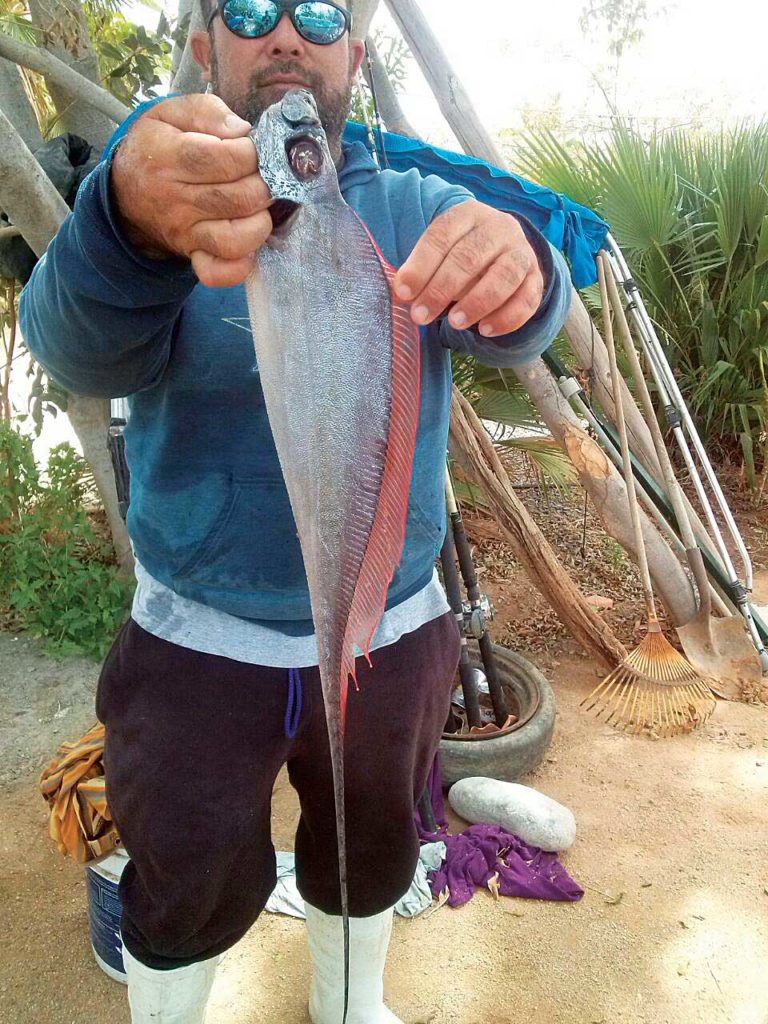
ANSWER:
Well, Gary, identification of this fish turned out to be a bit tricky after I found several contenders. However, with the help of H.J. Walker at the Scripps Institution of Oceanography, I can say it’s likely a king-of-the-salmon, Trachipterus altivelis. Ultimately, that long, long red dorsal fin, the skinny caudal fin, and the lack of any spots or blotches told the tale. This wide-ranging species is found from the Bering Sea to Chile, so your Cerralvo Island fish is right in the middle of its range. It’s clearly a juvenile because adults grow to more than 8 feet. Juveniles tend to live near the surface, while adults are often deeper, down to about 4,000 feet. This species feeds mostly on small fishes, squids and larger plankton. For obscure reasons, T. altivelis tend to beach themselves fairly often (a number of big ones were found on beaches in British Columbia in 2017). And how about that common name? King-of-the-salmon was the name given by the Makah people of Washington state. The Makah believed that this species led the hugely important salmon on their way to their spawning grounds. Because of this, it was forbidden to kill one.
—Milton Love
Red Sea Surprise
QUESTION:
I was fishing recently off the shore in Eilat, Israel, on the Red Sea, and caught this beautiful fish on a piece of squid. I released it after taking the photo. On very light tackle it put up a surprisingly good fight. I’ve never been able to figure out what kind of fish it is.
Tom Ogren
San Luis Obispo, California
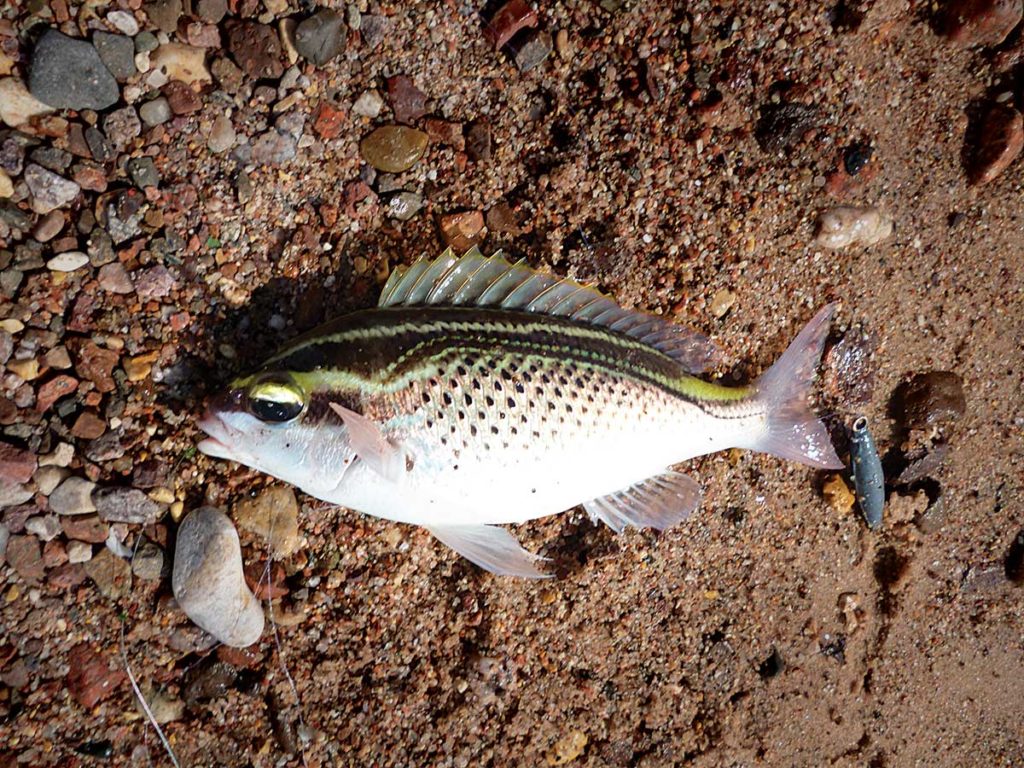
ANSWER:
What you’ve got there, Tom, is a pretty little Arabian monocle bream, Scolopsis ghanam, a member of the family Nemipteridae, which includes threadfin breams and whiptail breams. This group of fishes is common in coral-reef environments in the Indo-Pacific region, while the Arabian monocle bream is restricted in distribution to the western Indian Ocean region (the Red Sea, Persian Gulf, south to Madagascar, and as far east as the Andaman Islands). The species grows to a maximum size of around 12 inches long, a length fairly typical for most types of Nemipterids. These fish are bottom dwellers usually quite common on shallow sandy or rubble bottoms close to coral reefs, where they browse on crustaceans, mollusks, echinoderms and small fishes.
—Ben Diggles
Tails You Lose
QUESTION:
While fishing in one of the creeks that feeds the York River near Williamsburg, Virginia, my fishing buddy pulled in this tailless puppy drum. There was no evidence of scarring where the tail should have been. The dorsal fin, as you can see, has extended the full length of the body curving almost all the way down to the rear of the fish. The debate is whether the fish lost its tail early or was hatched without it. What are your thoughts on the matter? Either way it is remarkable this puppy drum has been able to survive and thrive.
Mike Furiness
Williamsburg, Virginia
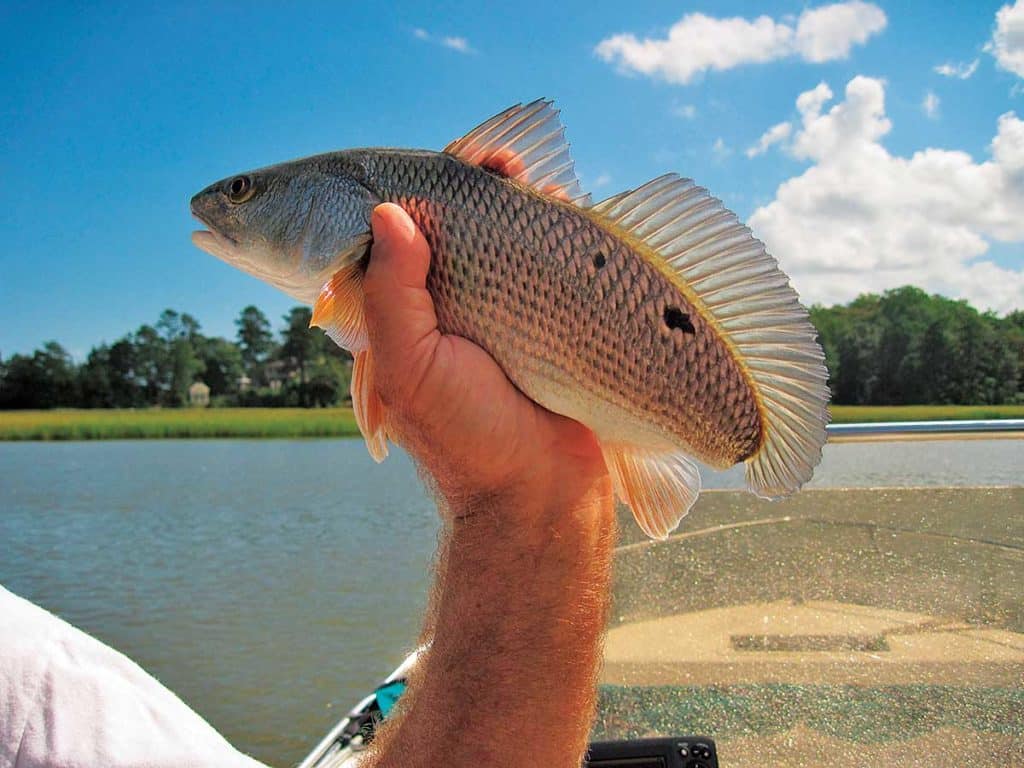
ANSWER:
That’s an interesting anomaly, Mike. My guess — and that’s really all I can offer — is that this red drum (Sciaenops ocellatus) was injured early in life and developed this way. An injury to a larva or early juvenile would greatly limit the amount of scar tissue present in the area of the wound.
Many fishes swim nearly as well without their caudal fin as they do if the fin were intact. As their bodies flex, posteriorly moving waves form along their sides. These push against the water, propelling the fishes forward. Although they might lose some speed and maneuverability, they might still be able to survive. In this case, a red drum that is able to capture slow-moving, benthic prey and that inhabits shallow water might be able to feed successfully and avoid predators. One interesting characteristic regarding your catch is the way the fish’s dorsal fin somewhat wraps around the rear portion of its body. This could help serve as a replacement for a missing caudal fin. The injury or anomaly occurred behind the fish’s anal fin, so the drum’s internal organs would not have been damaged.
—Ray Waldner
Read Next: Strange Fishes from the Deep — Queensland Grouper and More
Sport Fishing‘s Prestigious International Panel of Experts
Northeast
Mike Fahay, Sandy Hook Marine Lab, New Jersey
Southeast
Ray Waldner, Ph.D., Palm Beach Atlantic University, Florida
Gulf of Mexico
Bob Shipp, Ph.D., University of South Alabama
West Coast
Milton Love, Ph.D., UCSB, California
Far Pacific
Ben Diggles, Ph.D., Queensland, Australia
Bluewater Pelagics
John Graves, Ph.D., Virginia Institute of Marine Science
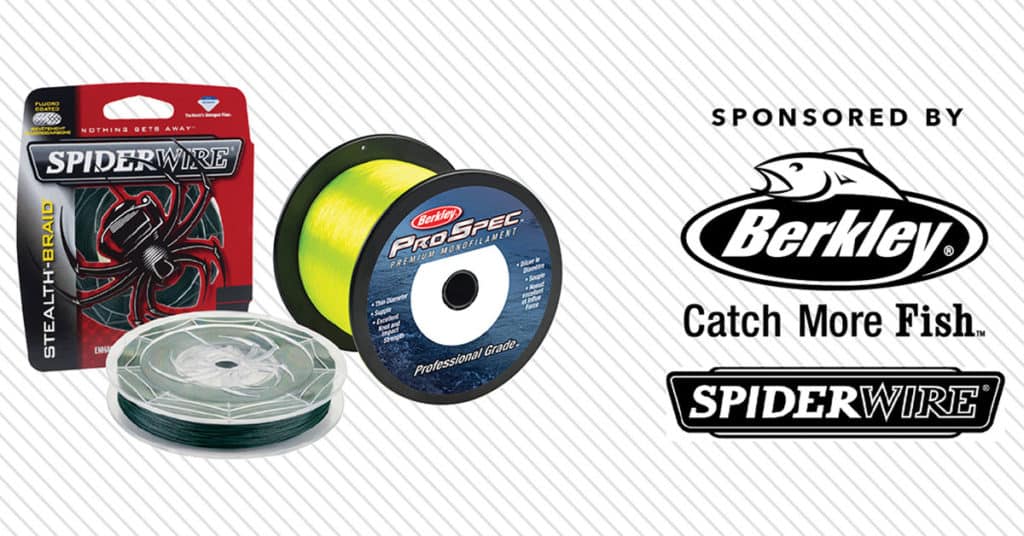
CHALLENGE OUR EXPERTS (And Win Up to 10,800 Yards of Line!)
Send in your question and any relevant photos of your mysterious catch or observation for our experts’ ID and feedback. If we publish your question and you have a shipping address within the United States or Canada, you’ll win a 3‑pound spool of Berkley Pro Spec ocean-blue or fluorescent-yellow monofilament (1,000 to 10,800 yards, depending on line strength) or a 1,500‑yard spool of Spiderwire Stealth braid up to 100‑pound‑test! Send questions and images via email to fishfacts@sportfishing.com (include your hometown) or via post to Sport Fishing Fish Facts, 460 N. Orlando Ave., Suite 200, Winter Park, FL 32789.

